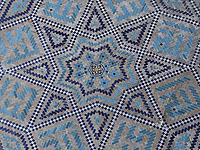 |
|
Uzbekistan - Milestones of History |
||||
|
History and modernity, the past and the present are unbreakable. They are the link to which are strung the events of the past, like pearls. From early generations down to the latest, stories and myths are told, traditions and customs are taught, and documentary evidence of the past is passed on. Each epoch leaves behind monuments in the form of cities that existed before and also works of art. And all this comprises the foundation of people's inheritance, their historical property. Uzbekistan is a country of an ancient civilization. There are thousands of monuments of archaeology and architecture preserved on its territory. Numerous manuscripts and items of both ancient and recent past of the area are kept in research centers and museums. In recent years, significant changes have been observed with regard to the true historical past of the area, spiritual values and traditions of the people that inhabited the region. Thus, a deep and objective study of the history of the peoples of Uzbekistan, based on first-hand sources, now has been launched in the country. National festivals and rituals have been revived, freedom of faith is fully maintained, and the national self-conscience and dignity of the peoples now residing in Uzbekistan have been recovered. The identities of tens of great personalities - statesmen, scientists and thinkers - are being restored in the country. The celebration of remarkable dates is significant vis-a-vis restoring the national self-consciousness and historical culture of the area. The 2500th anniversary of the world-famous cities of Bukhara and Khiva, 660th anniversary of the great statesman, Amir Temur (Tamerlane), the jubilees of the greatest scientists such as Akhmad Al-Farghony, Imam Al-Bukhary, Bakhauddin Nakshbandy Ulughbek, Navoi, and many others were celebrated nationwide. All of these festivals were launched under the auspices of UNESCO, and have received wide international response. Besides, each celebration served as vivid evidence of the enormous contribution our ancestors had made with their treasury of global culture. Uzbekistan, being at the heart of the Central Asian region, served and still continues to serve as a center for important historical events. Therefore, while talking about the history of its people, looking at the events and studying the monuments of the past, it would be impossible to stay within today's geographical and administrative borders. Since both in ancient and medieval times, the territory of present Uzbekistan was fully or partly a part of neighboring provinces, or still - united them into one historical and cultural unit and state. From ancient times the historical fate of the peoples of Central Asia has been closely interconnected with each other, making one historical area stretching from China to India. Along with that, the people's history and the one of its contemporary identity (i.e., its naming) could not be considered the same, due to the point that the former is much more ancient than the latter. And naturally, the history of the Uzbek people doesn't commence from the times when the term "Uzbeks" came on the scene, but from the most ancient times of emergence of human society in the given territory. The current territory of the Republic of Uzbekistan is one of the seats of an active primitive settlement. The traces of primeval humans in the form of primitive labor instruments, habitation, and temporary settlements are found in various zones ranging from mountain tracts and sands of the Kyzyl Kum deserts. The climatic conditions and favorable ecological environment of the Central Asian region served important prerequisites for emerging here of initial dwellings of ancient humans and development of primitive society. As the places of their habitation, the primitive men used to choose mountain slopes, river valleys, and plains with an abundance of wildlife - animals, birds, and fish. Mostly, initial inhabitants used caves for their shelter. This period is usually referred to as the Lower Paleolithic (about from 700-600 until 100000 years B.C.) Some stone tools of this period were discovered in the Sokh River valley (The Selengur cave), flood-lands of the Okhangaron River (The Kolbuloq settlement), Baysuntogh Mountains and Zarafshon oasis (Omonkuton, Zirabuloq, and Kuturbuloq). Silk Road Tours - Inineraries of tours along the ancient silk road |


